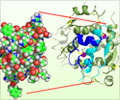Estimating the levels of hemoglobin A 1c in patients with diabetes may help predict the risk of cardiovascular disease (CVD), reveals report published in Archives of Internal Medicine.

Nina P. Paynter, Ph.D., from Brigham and Women's Hospital, Boston, and colleagues, used data from participants of the Women's Health Study and the Physician's Health Study II. To generate the model, they included data from 24,674 women, of whom 685 had diabetes at baseline, and 11,280 men, of whom 563 had diabetes at baseline. Questionnaires provided participants' health history, and baseline blood samples were evaluated for cholesterol, C-reactive protein and HbA 1c levels. The researchers followed up participants for incident (new cases) CVD; women were followed up for a median (midpoint) of 10.2 years and men for a median of 11.8 years.
During follow-up, 125 cardiovascular events occurred in the 685 women with diabetes and 170 events occurred in the 563 men with diabetes (compared with 666 and 1,382 events, respectively, in participants without diabetes). In both sexes, including HbA 1c into risk modeling for CVD improved prediction of CVD compared to classification of all diabetic participants as high risk (10-year risk at least 20 percent). This association was especially pronounced in women. The risk modeling demonstrated that 71.9 percent of female diabetic participants had less than a 20 percent risk of CVD over 10 years, whereas only 24.5 percent of male diabetic participants had a predicted 10-year CVD risk of less than 20 percent. In models that included a term for HbA 1c , there was substantial improvement in CVD risk prediction for women, and more modest improvement in risk prediction for men. Using a yes/no term for diabetes instead of HbA 1c also improved prediction over classification as high risk in both men and women. In women, however, HbA 1c further improved prediction over the yes/no term.
"We found that in these large population-based cohorts of both men and women, presence of diabetes alone did not confer a 10-year risk of CVD higher than 20 percent, and measurement of HbA 1c level in diabetic subjects improved risk prediction compared with classification as cardiovascular risk equivalent," note the researchers. They propose that the difference in risk between the sexes may be partly attributed to the increase in CVD risk with age and the delayed risk in women. The authors call for further research to replicate their results, but conclude, "Our findings suggest that the improvement in CVD risk prediction, and possibly calibration, obtained with adding HbA 1c levels is highest in lower-risk populations."
Source-Eurekalert














